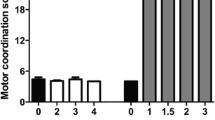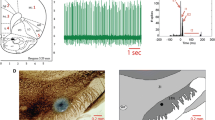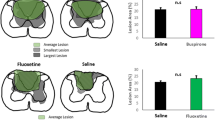Abstract
Rationale
The sensorimotor cortex and the striatum are interconnected by the corticostriatal pathway, suggesting that cortical injury alters the striatal function, which may be modulated by dopamine.
Objectives
We studied whether the activation of dopamine D1 receptors (D1Rs) modulates the γ-aminobutyric acid (GABA) and glutamate levels in the striatum of recovered rats at 192 h after cortical injury.
Methods
The D1R agonist SKF-38393 (0, 2, 3, or 4 mg/kg) was administered at 24, 48, 96, and 192 h post-injury, and then rats were decapitated to determine GABA and glutamate levels and the levels of D1R mRNA on both sides of the striatum.
Results
GABAergic imbalance in the striatum contralateral to the injury site was normalized by the administration of the D1R agonist, but this treatment did not produce a significant effect on glutamate levels, suggesting that glutamate was metabolized into GABA. The administration of SKF-38393 (2 mg/kg) decreased the levels of D1R mRNA in the striatum contralateral to the injury, and this effect was blocked by the coadministration of the D1R antagonist SCH-23390 (2 mg/kg). In the striatum ipsilateral to the injury, the D1R agonist increased the D1R mRNA levels, an effect that was blocked by SCH-23390.
Conclusion
The reversal of the GABAergic imbalance in the striatum contralateral to the cortical injury can be modulated by extrastriatal D1R activation, and the D1R agonist-induced increases in the D1R mRNA levels in the striatum ipsilateral to the injury suggest that the striatum may be necessary to achieve functional recovery.





Similar content being viewed by others
Abbreviations
- D1R:
-
dopamine D1 receptor
- D2R:
-
dopamine D2 receptor
- DA:
-
dopamine
- GABA:
-
γ-aminobutyric acid
- MSNs:
-
medium spiny neurons
- TBI:
-
traumatic brain injury
- SNc:
-
substantia nigra pars compacta
- M1:
-
primary motor cortex
- HPLC:
-
high-performance liquid chromatography
- PKA:
-
protein kinase A
- DARPP-32:
-
DA- and cAMP-regulated phosphoprotein 32
References
Abekawa T, Ohmori T, Ito K, Koyama T (2000) D1 dopamine receptor activation reduces extracellular glutamate and GABA concentrations in the medial prefrontal cortex. Brain Res 867:250–254
Amorini AM, Lazzarino G, Di Pietro V, Signoretti S, Belli A, Tavazzi B (2017) Severity of experimental traumatic brain injury modulates changes in concentrations of cerebral free amino acids. J Cell Mol Med 21:530–542
Avila-Luna A, Galvez-Rosas A, Alfaro-Rodriguez A, Reyes-Legorreta C, Garza-Montano P, Gonzalez-Pina R, Bueno-Nava A (2018a) Dopamine D1 receptor activation maintains motor coordination in injured rats but does not accelerate the recovery of the motor coordination deficit. Behav Brain Res 336:145–150
Avila-Luna A, Galvez-Rosas A, Durand-Rivera A, Ramos-Languren LE, Rios C, Arias-Montano JA, Bueno-Nava A (2018b) Dopamine D1 receptor activation maintains motor coordination and balance in rats. Metab Brain Dis 33:99–105
Bales JW, Wagner AK, Kline AE, Dixon CE (2009) Persistent cognitive dysfunction after traumatic brain injury: a dopamine hypothesis. Neurosci Biobehav Rev 33:981–1003
Bales JW, Yan HQ, Ma X, Li Y, Samarasinghe R, Dixon CE (2011) The dopamine and cAMP regulated phosphoprotein, 32 kDa (DARPP-32) signaling pathway: a novel therapeutic target in traumatic brain injury. Exp Neurol 229:300–307
Bergson C, Mrzljak L, Smiley JF, Pappy M, Levenson R, Goldman-Rakic PS (1995) Regional, cellular, and subcellular variations in the distribution of D1 and D5 dopamine receptors in primate brain. J Neurosci 15:7821–7836
Bjorklund A, Dunnett SB (2007) Dopamine neuron systems in the brain: an update. Trends Neurosci 30:194–202
Bostan AC, Strick PL (2010) The cerebellum and basal ganglia are interconnected. Neuropsychol Rev 20:261–270
Brailowsky S, Knight RT, Blood K, Scabini D (1986) Gamma-aminobutyric acid-induced potentiation of cortical hemiplegia. Brain Res 362:322–330
Bueno-Nava A, Montes S, DelaGarza-Montano P, Alfaro-Rodriguez A, Ortiz A, Gonzalez-Pina R (2008) Reversal of noradrenergic depletion and lipid peroxidation in the pons after brain injury correlates with motor function recovery in rats. Neurosci Lett 443:32–36
Bueno-Nava A, Gonzalez-Pina R, Alfaro-Rodriguez A, Nekrassov-Protasova V, Durand-Rivera A, Montes S, Ayala-Guerrero F (2010) Recovery of motor deficit, cerebellar serotonin and lipid peroxidation levels in the cortex of injured rats. Neurochem Res 35:1538–1545
Bullock R, Zauner A, Woodward JJ, Myseros J, Choi SC, Ward JD, Marmarou A, Young HF (1998) Factors affecting excitatory amino acid release following severe human head injury. J Neurosurg 89:507–518
Bunzow JR, Van Tol HH, Grandy DK, Albert P, Salon J, Christie M, Machida CA, Neve KA, Civelli O (1988) Cloning and expression of a rat D2 dopamine receptor cDNA. Nature 336:783–787
Camps M, Kelly PH, Palacios JM (1990) Autoradiographic localization of dopamine D1 and D2 receptors in the brain of several mammalian species. J Neural Transm Gen Sect 80:105–127
Cantu D, Walker K, Andresen L, Taylor-Weiner A, Hampton D, Tesco G, Dulla CG (2015) Traumatic brain injury increases cortical glutamate network activity by compromising GABAergic control. Cereb Cortex 25:2306–2320
Chagniel L, Robitaille C, Lacharite-Mueller C, Bureau G, Cyr M (2012) Partial dopamine depletion in MPTP-treated mice differentially altered motor skill learning and action control. Behav Brain Res 228:9–15
Chamoun R, Suki D, Gopinath SP, Goodman JC, Robertson C (2010) Role of extracellular glutamate measured by cerebral microdialysis in severe traumatic brain injury. J Neurosurg 113:564–570
Daskalakis ZJ, Paradiso GO, Christensen BK, Fitzgerald PB, Gunraj C, Chen R (2004) Exploring the connectivity between the cerebellum and motor cortex in humans. J Physiol 557:689–700
De Beaumont L, Tremblay S, Poirier J, Lassonde M, Theoret H (2012) Altered bidirectional plasticity and reduced implicit motor learning in concussed athletes. Cereb Cortex 22:112–121
Ding J, Peterson JD, Surmeier DJ (2008) Corticostriatal and thalamostriatal synapses have distinctive properties. J Neurosci 28:6483–6492
Doya K (2000) Complementary roles of basal ganglia and cerebellum in learning and motor control. Curr Opin Neurobiol 10:732–739
Festing MF (1994) Reduction of animal use: experimental design and quality of experiments. Lab Anim 28:212–221
Folkersma H, Foster Dingley JC, van Berckel BN, Rozemuller A, Boellaard R, Huisman MC, Lammertsma AA, Vandertop WP, Molthoff CF (2011) Increased cerebral (R)-[11C]PK11195 uptake and glutamate release in a rat model of traumatic brain injury: a longitudinal pilot study. J Neuroinflammation 8:67
Gerfen CR, Surmeier DJ (2011) Modulation of striatal projection systems by dopamine. Annu Rev Neurosci 34(34):441–466
Guerriero RM, Giza CC, Rotenberg A (2015) Glutamate and GABA imbalance following traumatic brain injury. Curr Neurol Neurosci Rep 15:27
Hayes JP, Bigler ED, Verfaellie M (2016) Traumatic brain injury as a disorder of brain connectivity. J Int Neuropsychol Soc 22:120–137
Hinzman JM, Thomas TC, Burmeister JJ, Quintero JE, Huettl P, Pomerleau F, Gerhardt GA, Lifshitz J (2010) Diffuse brain injury elevates tonic glutamate levels and potassium-evoked glutamate release in discrete brain regions at two days post-injury: an enzyme-based microelectrode Array study. J Neurotrauma 27:889–899
Hinzman JM, Thomas TC, Quintero JE, Gerhardt GA, Lifshitz J (2012) Disruptions in the regulation of extracellular glutamate by neurons and glia in the rat striatum two days after diffuse brain injury. J Neurotrauma 29:1197–1208
Hoskison MM, Moore AN, Hu B, Orsi S, Koboric N, Dash PK (2009) Persistent working memory dysfunction following traumatic brain injury: evidence for a time-dependent mechanism. Neuroscience 159:483–491
Hsu KS, Huang CC, Yang CH, Gean PW (1995) Presynaptic D2 dopaminergic receptors mediate inhibition of excitatory synaptic transmission in rat neostriatum. Brain Res 690:264–268
Jiang L, Li WL, Mamtilahun M, Song YY, Ma YY, Qu MJ, Lu YF, He XS, Zheng JY, Fu ZJ, Zhang ZJ, Yang GY, Wang YT (2017) Optogenetic inhibition of striatal GABAergic neuronal activity improves outcomes after ischemic brain injury. Stroke 48:3375–3383
Kantak SS, Stinear JW, Buch ER, Cohen LG (2012) Rewiring the brain: potential role of the premotor cortex in motor control, learning, and recovery of function following brain injury. Neurorehabil Neural Repair 26:282–292
Kerkerian L, Dusticier N, Nieoullon A (1987) Modulatory effect of dopamine on high-affinity glutamate uptake in the rat striatum. J Neurochem 48:1301–1306
Krobert KA, Sutton RL, Feeney DM (1994) Spontaneous and amphetamine-evoked release of cerebellar noradrenaline after sensorimotor cortex contusion: an in vivo microdialysis study in the awake rat. J Neurochem 62:2233–2240
Le Moine C, Bloch B (1995) D1 and D2 dopamine receptor gene expression in the rat striatum: sensitive cRNA probes demonstrate prominent segregation of D1 and D2 mRNAs in distinct neuronal populations of the dorsal and ventral striatum. J Comp Neurol 355:418–426
Lei WL, Jiao Y, Del Mar N, Reiner A (2004) Evidence for differential cortical input to direct pathway versus indirect pathway striatal projection neurons in rats. J Neurosci 24:8289–8299
Lidow MS, Goldmanrakic PS, Gallager DW, Rakic P (1991) Distribution of dopaminergic receptors in the primate cerebral-cortex—quantitative autoradiographic analysis using 3H raclopride, 3H spiperone and 3H SCH23390. Neuroscience 40:657–671
López de Maturana R, Sánchez-Pernaute R (2010) Regulation of corticostriatal synaptic plasticity by G protein-coupled receptors. Cns Neurol Disord-Drug Targets 9:601–615
Mathai A, Smith Y (2011) The corticostriatal and corticosubthalamic pathways: two entries, one target. So what? Front Syst Neurosci 5:1–10
Mendoza G, Merchant H (2014) Motor system evolution and the emergence of high cognitive functions. Prog Neurobiol 122:73–93
Missale C, Nash SR, Robinson SW, Jaber M, Caron MG (1998) Dopamine receptors: from structure to function. Physiol Rev 78:189–225
Montes S, Alcaraz-Zubeldia M, Muriel P, Rios C (2003) Role of manganese accumulation in increased brain glutamine of the cirrhotic rat. Neurochem Res 28:911–917
Muly EC, Szigeti K, Goldman-Rakic PS (1998) D1 receptor in interneurons of macaque prefrontal cortex: distribution and subcellular localization. J Neurosci 18:10553–10565
Olfert E, Cross B, Mc William A (1993) Guide for the care and use of experimental animals. Can Counc Anim Care 1:211
Paxinos G, Watson C (2007) The rat brain in stereotaxic coordinates, 6th edn. Academic Press, London
Petroff OAC (2002) GABA and glutamate in the human brain. Neuroscientist 8:562–573
Reep RL, Cheatwood JL, Corwin JV (2003) The associative striatum: organization of cortical projections to the dorsocentral striatum in rats. J Comp Neurol 467:271–292
Reiner A, Hart NM, Lei WL, Deng YP (2010) Corticostriatal projection neurons - dichotomous types and dichotomous functions. Front Neuroanat 4:1–15
Shin SS, Bray ER, Zhang CQ, Dixon CE (2011) Traumatic brain injury reduces striatal tyrosine hydroxylase activity and potassium-evoked dopamine release in rats. Brain Res 1369:208–215
Silberberg G, Bolam JP (2015) Local and afferent synaptic pathways in the striatal microcircuitry. Curr Opin Neurobiol 33:182–187
Smith Y, Raju DV, Pare JF, Sidibe M (2004) The thalamostriatal system: a highly specific network of the basal ganglia circuitry. Trends Neurosci 27:520–527
Sunahara RK, Guan HC, O'Dowd BF, Seeman P, Laurier LG, Ng G, George SR, Torchia J, Van Tol HH, Niznik HB (1991) Cloning of the gene for a human dopamine D5 receptor with higher affinity for dopamine than D1. Nature 350:614–619
Surmeier DJ, Song WJ, Yan Z (1996) Coordinated expression of dopamine receptors in neostriatal medium spiny neurons. J Neurosci 16:6579–6591
Surmeier DJ, Ding J, Day M, Wang Z, Shen W (2007) D1 and D2 dopamine-receptor modulation of striatal glutamatergic signaling in striatal medium spiny neurons. Trends Neurosci 30:228–235
Tremblay S, Beaule V, Proulx S, Marjanska M, Doyon J, Lassonde M, Theoret H (2014) Multimodal assessment of primary motor cortex integrity following sport concussion in asymptomatic athletes. Clin Neurophysiol 125:1371–1379
Valjent E, Bertran-Gonzalez J, Herve D, Fisone G, Girault J-A (2009) Looking BAC at striatal signaling: cell-specific analysis in new transgenic mice. Trends Neurosci 32:538–547
Van Tol HH, Bunzow JR, Guan HC, Sunahara RK, Seeman P, Niznik HB, Civelli O (1991) Cloning of the gene for a human dopamine D4 receptor with high affinity for the antipsychotic clozapine. Nature 350:610–614
Vespa P, Prins M, Ronne-Engstrom E, Caron M, Shalmon E, Hovda DA, Martin NA, Becker DP (1998) Increase in extracellular glutamate caused by reduced cerebral perfusion pressure and seizures after human traumatic brain injury: a microdialysis study. J Neurosurg 89:971–982
Wagner AK, Sokoloski JE, Ren D, Chen X, Khan AS, Zafonte RD, Michael AC, Dixon CE (2005) Controlled cortical impact injury affects dopaminergic transmission in the rat striatum. J Neurochem 95:457–465
Wang YH, Zhou FM (2017) Striatal but not extrastriatal dopamine receptors are critical to dopaminergic motor stimulation. Front Pharmacol 8:1–13
Wickens JR, Wilson CJ (1998) Regulation of action-potential firing in spiny neurons of the rat neostriatum in vivo. J Neurophysiol 79:2358–2364
Wu JH, Corwin JV, Reep RL (2009) Organization of the corticostriatal projection from rat medial agranular cortex to far dorsolateral striatum. Brain Res 1280:69–76
Acknowledgments
We thank MVZ Hugo Lecona Butrón for the support with the housing, care, maintenance, and monitoring the health of the experimental animals in the INR-LGII. We thank MVZ Javier Pérez Gallaga and M en C René Valdez Mijares for technical support.
Funding
This work was supported by INR-LGII, CONACyT (grant 288512 to A. Avila-Luna).
Author information
Authors and Affiliations
Corresponding author
Additional information
Publisher’s note
Springer Nature remains neutral with regard to jurisdictional claims in published maps and institutional affiliations.
Rights and permissions
About this article
Cite this article
Gálvez-Rosas, A., Avila-Luna, A., Valdés-Flores, M. et al. GABAergic imbalance is normalized by dopamine D1 receptor activation in the striatum contralateral to the cortical injury in motor deficit-recovered rats. Psychopharmacology 236, 2211–2222 (2019). https://doi.org/10.1007/s00213-019-05215-1
Received:
Accepted:
Published:
Issue Date:
DOI: https://doi.org/10.1007/s00213-019-05215-1




